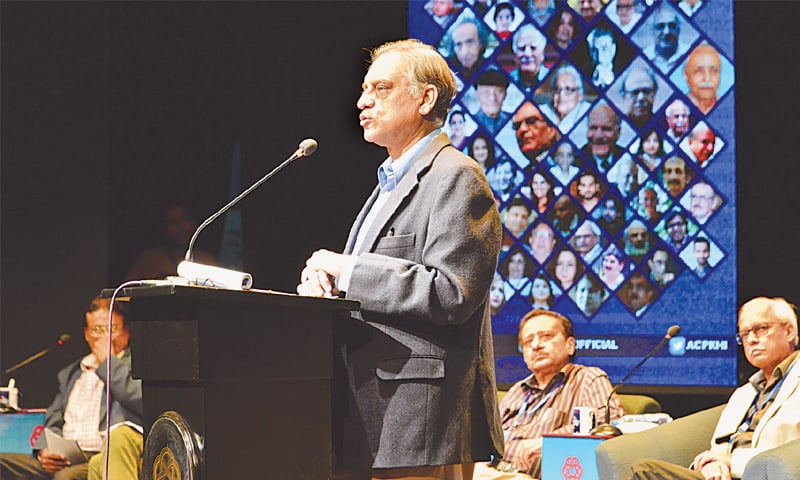KARACHI: It was thoughtful of Dr Asif Farrukhi to bring up the name of Fahmida Riaz, the poet and writer who passed away on Nov 21, as an under-discussed short story writer and novelist in his paper read during the first post-lunch session on fiction at the 11th International Urdu Conference at the Arts Council on Friday.
Dr Farrukhi’s topic was Urdu short story in the post-symbolism era. He said the short story wasn’t a static genre. It changed shape with time. The 1960s was a reaction to its preceding era in which symbolism was employed and in the 1970s the afsana was written under the influence of modernism. It was served by literary giants such as Intizar Husain, Anwer Sajjad and Mansha Yaad.
Then Dr Farrukhi drew the audience’s attention to Fahmida Riaz. He said everyone knew her as a poet, but she wrote short stories as well. A new kind of sensibility was noticeable in her writings. She got more involved in fiction writing after she returned from India where she spent seven years in exile. She wrote top-notch stories in that period. The great thing about her was that she was an avid reader of international literatures. She would read works by the likes of Margaret Atwood and think about how their technique would work in Urdu fiction. She translated many pieces of fiction penned in English (or adapted in English) into Urdu.
Writers now lean towards one ideology or another, say scholars
Dr Farrukhi mentioned Riaz’s Hum Loag, a collection of three novels. He called them form-bending. He also touched upon some other stories written by her, such as Qafiley Parindon Ke, lamenting that they’re not discussed the way they merited.
Undiscovered travelogues
Earlier, the session started off with Daniel Joseph’s interesting paper on the undiscovered travelogues written in Urdu by women writers. He said he had been working on a project for the past three years to gather travelogues by female writers and translate them into English. The book (that he’s working on) would be published in six months.
Mr Joseph said in his research he found out that most of the travelogues were about women’s travels within India. There were also about those in which they’d gone to perform Haj. And some of them were about their visit to Europe. The writings hinted at diversity of styles and regions from where they originated. Among the names that the young researcher took was of Atiya Faizi, Fatima Begum and Mehrunnisa. Fatima went for Haj in 1940, whereas Mehrunnisa’s travel piece was about her visit to Ohio in 1947.
Zaib Azkaar Husain in his paper pointed out that social consciousness (samaji shaoor) was an added bit of terminology used in our literature. The work of writers came about in the “existing state of affairs”.
Akhlaq Ahmed spoke on Urdu short story after 9/11. He said the events of Sept 11, 2001, made writers in the West use the question raised by Theodore Adorno after WWII that “how can anyone write poetry that can comprehend the barbarity of the Holocaust” with great resonance. In our part of the world, a subconscious change came in Urdu short stories. Now writers didn’t think that impartiality was a positive trait. They leaned towards one ideology or another.
M. Hameed Shahid talked about the various forms and narrative styles that had been employed in Urdu fiction. He first highlighted novels, beginning with Shamsur Rehman Farooqi’s Kai Chand Thay Sar-i-Asmaan, in which he claimed culture was the dominant feature of its narrative. He said in the novel Dukhyarey by Anis Ashfaq, the reader saw the culture of a particular era come apart, bit by bit. Among the younger lot of novelists, he took Akhtar Raza Saleemi’s name and touched upon his book Jindar.
In the latter half of his speech, Mr Shahid mentioned quite a few names of short story writers who were doing a good job. Summing up his arguments he said Urdu fiction was marked by contemporary sensibility, the making of fresh aesthetic values and individual creative experiences.
Mirza Hamid Baig, Aslam Jamshedpuri and Khalid Mahmood Sanjrani also spoke. The session was conducted by Auj-i-Kamal and those who presided over it included Masood Ashar, Asad Mohammad Khan, Mustansar Husain Tarar and Aamer Hussein.
Published in Dawn, November 24th, 2018
















































Dear visitor, the comments section is undergoing an overhaul and will return soon.